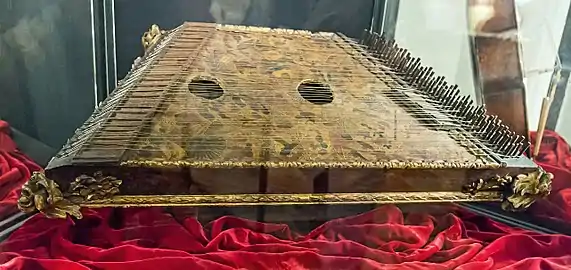Psaltery
A psaltery (Greek: ψαλτήρι) (or sawtry [archaic]) is a stringed instrument of the zither family.



Etymology
The psaltery of Ancient Greece (epigonion) was a harp-like stringed instrument. The word psaltery derives from the Ancient Greek ψαλτήριον (psaltḗrion), "stringed instrument, psaltery, harp"[1] and that from the verb ψάλλω (psállō), "to touch sharply, to pluck, pull, twitch" and in the case of the strings of musical instruments, "to play a stringed instrument with the fingers, and not with the plectrum."[2] The psaltery was originally made from wood, and relied on natural acoustics for sound production.
In the King James Bible "psaltery", and its plural, "psalteries", are used to translate several words from the Hebrew Bible whose meaning is now unknown.[3]
Characteristics
The strings of the medieval instrument were usually made of metal, unlike the finger plucked harp made with gut strings. There are many illustrations that show the instrument being played with a plectrum. While the harp had single strips, a psaltery could have multiple strings for one tone. It had a soundboard under the strings. The psaltery has been compared to the harpsichord[4] and dulcimer, though the latter is not plucked but struck with hammers.[5]
Medieval and Renaissance psalteries

From the 12th through the 15th centuries, psalteries are widely seen in manuscripts, paintings and sculpture throughout Europe.[6] They vary widely in shape and the number of strings (which are often, like lutes, in courses of two or more strings).
Modern psaltery
While psalteries had largely died out in Europe by the 19th century, the salterio remained common in Mexico well into the twentieth century and is still played in some regional styles.
The hammered dulcimer and related instruments such as the santur, cimbalom, yangqin, and khim, appear very similar to psalteries and it is often hard to tell which one historical images represent. They differ in that the player strikes the strings with small hammers rather than plucking them. As a result, they have much higher string tension and heavier frames.
In the 19th century, several related zithers came into use, notably the guitar zither and the autoharp. In the 20th century, the bowed psaltery came into wide use. It is set up in a triangular format so that the end portion of each string can be bowed.
See also
Notes
- ψαλτήριον, Henry George Liddell, Robert Scott, A Greek-English Lexicon, on Perseus
- ψάλλω, Henry George Liddell, Robert Scott, A Greek-English Lexicon, on Perseus
- These words are the Hebrew keli (כלי) in Psalm 71:22 and I Chronicles 16:5; nevel (נבל) in I Samuel 10:5; 2 Samuel 6:5; I Kings 10:12; I Chronicles 13:8; 15:16, 20, 28; 25:1, 6; II Chronicles 5:12; 9:11; 20:28; 29:25; Nehemiah 12:27; Psalms 33:2; 57:6; 81:2; 92:3; 108:2; 144:9; and 150:3; and the Aramaic pesanterin (פסנתרין) in Daniel 3:5, 7, 10, and 15.
- Bucur, Voichita. Handbook of Materials for String Musical Instruments. Springer. p. 51. ISBN 3319320807. Retrieved 10 August 2019.
- Jackson, Ronald (2013). Performance Practice: A Dictionary-Guide for Musicians. Routledge. p. 322. ISBN 113676769X. Retrieved 10 August 2019.
- Anon. (15th century). "Roi David jouant du psaltérion". (Chambéry, Savoie, France: manuscrit 4, fol. 319 v., Bréviaire franciscain, initiale B, psaume 1, Beatus vir) Musiconis.huma-num.fr (archive from 17 November 2018, accessed 15 June 2020).
References
- Chisholm, Hugh, ed. (1911). . Encyclopædia Britannica (11th ed.). Cambridge University Press.
External links
| Wikimedia Commons has media related to Psaltery. |